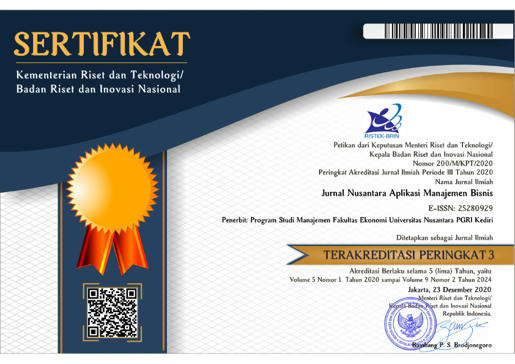Analisis Purchasing Intention Melalui Penggunaan Augmented Reality Di Aplikasi Belanja Online
DOI:
https://doi.org/10.29407/nusamba.v8i2.18466Keywords:
Online purchase intention, augmented reality, perceived ease of use, perceived enjoyment, personal innovativenessAbstract
Research aim: This study aims to analyze consumers' online purchase intentions by adopting AR technology in online sales applications in Indonesia. The main objective of this study is to analyze the extent of the influence of perceived ease of use, the effect of perceived pleasure, and the influence of personal innovation on attitudes towards AR in online purchasing as a mediating variable with online purchase intention being the dependent variable.
Design/Methode/Approach: The research method used in this research is path analysis using the AMOS program before the path analysis goodness of fit test is performed to test the model's fit. The sampling method used is non-probability sampling with the purposive sampling method. The sampling criteria used in this study are consumers who are interested in buying using AR technology or have used AR technology in online shopping applications.
Research Finding: People feel that AR technology makes purchasing easier. People who tend to be open to using AR technology are people who have a high level of innovation. This result of the research filled the gap of the use of technology involvement in the marketing area.
Theoretical contribution/Originality: Based on these results, The contribution of the research is to bring clarity and development of the technology involved in the marketing field, particularly the use of AR technology.
Practitioner/Policy implication: The implications for companies need to make appropriate and fun promotional strategies such as advertising with the aim of building positive attitudes of prospective consumers towards the use of AR in e-commerce media and providing instructions for using AR technology in an interesting way, for example by collaborating with celebrities or celebrity endorsers.
Research limitation: This research is limited to shopping applications only. So it is necessary further to investigate the use of AR in other applications.
Downloads
References
Potia A, Dahiya K. Generous : COVID-19 ’ s Impact on Indonesian Consumer Sentiment. 2020.
Ehab M, Adel R, Abdelmoaty H. The Effect of Augmented Reality Applications on Customer’s Purchase Intentions. Int J Adv Sci Res Manag 2020;5:34. https://doi.org/10.36282/ijasrm/5.11.2020.1777.
Ramdani MA, Belgiawan PF, Aprilianty F, Purwanegara MS. Consumer Perception and the Evaluation to Adopt Augmented Reality in Furniture Retail Mobile Application. Binus Bus Rev 2022;13:41–56. https://doi.org/10.21512/bbr.v13i1.7801.
Alam SS, Susmit S, Lin CY, Masukujjaman M, Ho YH. Factors affecting augmented reality adoption in the retail industry. J Open Innov Technol Mark Complex 2021;7:1–24. https://doi.org/10.3390/joitmc7020142.
Ruyter K De, Heller J, Hilken T, Chylinski M, Keeling DI, Mahr D, et al. Seeing with the Customer ’ s Eye : Exploring the Challenges and Opportunities of AR Advertising Seeing with the Customer ’ s Eye : Exploring the Challenges and Opportunities of AR Advertising. J Advert 2020;0:1–16. https://doi.org/10.1080/00913367.2020.1740123.
Turban E, King D, Lee JK, Liang T-P, Turban DC. Electronic Commerce - A Managerial and Social Perspective. 2015. https://doi.org/10.1016/S0267-3649(03)00504-1.
Boumphrey S. How will consumer markets evolve after Coronavirus ? 2020.
Jingen Liang L, Elliot S. A systematic review of augmented reality tourism research: What is now and what is next? Tour Hosp Res 2021;21:15–30. https://doi.org/10.1177/1467358420941913.
Wu ST, Chiu CH, Chen YS. The influences of innovative technological introduction on interpretive experiences of exhibition:a discussion on the intention to use augmented reality. Asia Pacific J Tour Res 2020;25:652–67. https://doi.org/10.1080/10941665.2020.1752754.
Álvarez-Marín A, Velázquez-Iturbide JÁ, Castillo-Vergara M. Technology acceptance of an interactive augmented reality app on resistive circuits for engineering students. Electron 2021;10. https://doi.org/10.3390/electronics10111286.
Chang SC, Sun CC, Pan LY, Wang MY. An Extended TAM to Explore Behavioural Intention of Consumers to Use M-Commerce. J Inf Knowl Manag 2015;14:1–16. https://doi.org/10.1142/S0219649215500148.
Zhou R, Feng C. Difference between leisure and work contexts: The roles of perceived enjoyment and perceived usefulness in predicting mobile video calling use acceptance. Front Psychol 2017;8:1–14. https://doi.org/10.3389/fpsyg.2017.00350.
Matute-Vallejo J, Melero-Polo I. Understanding online business simulation games: The role of flow experience, perceived enjoyment and personal innovativeness. Australas J Educ Technol 2019;35:71–85. https://doi.org/10.14742/ajet.3826.
Turan A, Tunç AÖ, Zehir C. A Theoretical Model Proposal: Personal Innovativeness and User Involvement as Antecedents of Unified Theory of Acceptance and Use of Technology. Procedia - Soc Behav Sci 2015;210:43–51. https://doi.org/10.1016/j.sbspro.2015.11.327.
Abubakre M, Zhou Y, Zhou Z. the impact of IT cultureand personal innovativeness in IT on digital entrepreneurship success. Inf Technol People 2020:31.
Ajzen I. Perceived Behavioral Control, Self-Efficacy, Locus of.pdf. J Appl Soc Psychol 2002;32:665–83.
Huedo-Martínez S, Molina-Carmona R, Llorens-Largo F. Study on the Attitude of Young People Towards Technology. Zaphiris, P., Ioannou, A. Learn. Collab. Technol. Learn. Teach., Springer; 2018. https://doi.org/https://doi.org/10.1007/978-3-319-91152-6_3.
Haryono S. Metode SEM Untuk Penelitian Manajemen dengan AMOS LISREL dan PLS. Bekasi: Badan Penerbit PT. Intermedia Personalia Utama; 2016.
Hair JF, Sarstedt M, Ringle CM, Mena JA. An assessment of the use of partial least squares structural equation modeling in marketing research. J Acad Mark Sci 2012;40:414–33. https://doi.org/10.1007/s11747-011-0261-6.
Leonnard, Paramita AS, Maulidiani JJ. The Effect of Augmented Reality Shopping Applications on Purchase Intention. J Bisnis Dan Manaj 2019;9:133–42. https://doi.org/https://doi.org/10.15408/ess.v9i2.9724.
Wedel M, Bigné E, Zhang J. Virtual and augmented reality: Advancing research in consumer marketing. Int J Res Mark 2020;37:443–65. https://doi.org/10.1016/j.ijresmar.2020.04.004.
Sugiono S. Tantangan dan Peluang Pemanfaatan Augmented Reality di Perangkat Mobile dalam Komunikasi Pemasaran. J Komunika J Komunikasi, Media Dan Inform 2021;10:1–12. https://doi.org/10.31504/komunika.v10i1.3715.
Jin O, Yazdanifard R. The review of the effectivity of the augmented reality experiential marketing tool in customer engagement. Glob J Manag Bus Res 2015;15:13–7.
Lau CKH, Chui CFR, Au N. Examination of the adoption of augmented reality: a VAM approach. Asia Pacific J Tour Res 2019;24:1005–20. https://doi.org/10.1080/10941665.2019.1655076.
Roxo MT, Brito PQ. Augmented reality trends to the field of business and economics: A review of 20 years of research. Asian J Bus Res 2018;8:94–117. https://doi.org/10.14707/ajbr.180051.
Masrom M. Technology acceptance model and E-learning. 12th Int Conf Educ 2007:21–4.
Pascoal R, Almeida A De, Sofia RC. Mobile Pervasive Augmented Reality Systems MPARS: The Role of User Preferences in the Perceived Quality of Experience in Outdoor Applications. ACM Trans Internet Technol 2020;20. https://doi.org/10.1145/3375458.
Brakus JJ, Schmitt BH, Zarantonello L. Brand Experience: What Is It? How Is It Measured? Does It Affect Loyalty? J Mark 2009;73:52–68. https://doi.org/10.1509/jmkg.73.3.52.
Huang TL, Liao S. A model of acceptance of augmented-reality interactive technology: the moderating role of cognitive innovativeness. Electron Commer Res 2015;15:269–95. https://doi.org/10.1007/s10660-014-9163-2.
Downloads
Published
Issue
Section
License
Authors who publish with this journal agree to the following terms:
- Copyright on any article is retained by the author(s).
- The author grants the journal, the right of first publication with the work simultaneously licensed under a Creative Commons Attribution License that allows others to share the work with an acknowledgment of the work’s authorship and initial publication in this journal.
- Authors are able to enter into separate, additional contractual arrangements for the non-exclusive distribution of the journal’s published version of the work (e.g., post it to an institutional repository or publish it in a book), with an acknowledgment of its initial publication in this journal.
- Authors are permitted and encouraged to post their work online (e.g., in institutional repositories or on their website) prior to and during the submission process, as it can lead to productive exchanges, as well as earlier and greater citation of published work.
- The article and any associated published material is distributed under the Creative Commons Attribution-ShareAlike 4.0 International License












